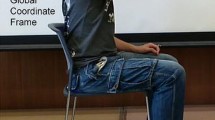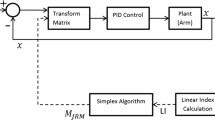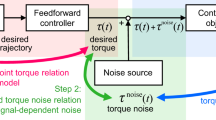Abstract
We have developed an inverse dynamics model of unrestrained natural reaching movements. Such movements are usually not planar and often involve complex deformation of the shoulder girdle as well as rotary and linear torso motion. Our model takes as its input kinematic data about the positions of the finger, wrist, elbow, left and right acromion processes, and the sternum and produces the torques and forces developed at the shoulder, elbow, and wrist joints. The model can also be used to simulate the consequences of introducing passive torso rotation or linear acceleration on arm movements and to simulate the consequences of applying mechanical perturbations to the reaching limb. It separately quantifies the contributions of inertial forces resulting from torso rotation and translation. In experimental paradigms involving arm movements, different dynamic components can be present such as active or passive torso rotation and translation, external forces and Coriolis forces. Our model provides a means of evaluating the different sources of force and the total muscle force needed to control the trajectory of the arm in their presence.







Similar content being viewed by others
Notes
From the equations in Zatsiorsky and Seluyanov (1985) we calculated that for an average person the two transverse momenta of inertia of the upper arm are approximately 140 kg cm2 and 130 kg cm2, respectively, with 20% variation for different body heights and weights. Consequently we model the upper arm as a cylindrical inertial ellipsoid.
The vertical component of the angular momentum is \({\bf h}_{\bf z} \cong \left({I_{{\rm T}} -I_{{\rm T}}} \right)\sin(\alpha)\cos(\alpha)\sin(\vartheta)\dot {\alpha}+ \left({I_{{\rm L}} \sin(\alpha)^2+}{I_{{\rm T}} \cos(\alpha)^2} \right)\left({\dot {\vartheta}^r+\dot {\vartheta}_{{\rm T}} +\omega} \right).\) From the data in Zatsiorsky and Seluyanov (1985), we calculated that I L is about 40 kg cm2 ± 16% across a variety of body heights and weights. Consequently, \(I_{{\rm L}} \approx {I_{{\rm T}}} \mathord{\left/ {\vphantom {{I_{{\rm T}}} 3}} \right. \kern-\nulldelimiterspace} 3.\) For reaching movements in typical paradigms, kinematics variations values are: \(\alpha \approx 55{\text{--}}35^{\circ}, \dot{\alpha}\approx 0{\text{--}}15^{\circ}/{\rm s}, \vartheta^r=0{\text{--}}90^{\circ},\) and \(\dot {\vartheta}^r=0\text{--}70^{\circ}/{\rm s}.\) With these numerical values the angular momentum can be simplified as follows, \({\bf h}_{\bf z} \cong \frac{I_{{\rm T}}}{3}\sin(2\alpha)\sin(\vartheta)\dot {\alpha}+\frac{I_{{\rm T}} }{3}\left({\sin(\alpha)^2+3\cos(\alpha)^2} \right)\left({\dot {\vartheta }^r+\dot {\vartheta}_{{\rm T}} +\omega} \right).\) In addition, the term in \(\dot {\alpha}\) is ten to 20 times smaller than the term including \(\dot {\vartheta}^r\) when the torso is not rotating \((\dot {\vartheta}_{{\rm T}} =\omega =0).\) Therefore, an excellent approximation for the vertical component of the angular momentum is \({\bf h}_{\bf z} \cong \frac{I_{{\rm T}}}{3}\left({\sin(\alpha )^2+3\cos(\alpha)^2} \right) \ \left({\dot {\vartheta}^r+\dot {\vartheta }_{{\rm T}} +\omega} \right)\).
\(\left. {\frac{{\rm d}{\bf h}}{{\rm d}t}} \right|_z =\mathop {\bf h}^\prime_z.\)
All forces F are (9 × 1) arrays.
References
Bortolami SB, Pigeon P, DiZio P, Lackner JR (2008) Kinetic analysis of arm reaching movements during voluntary and passive rotation of the Torso. Exp Brain Res. doi:10.1007/s00221-008-1321-0
Burdet E, Tee KP, Mareels I, Milner TE, Chew CM, Franklin DW, Osu R, Kawato M (2006) Stability and motor adaptation in human arm movements. Biol Cybern 94(1):20–32
Hollerbach JM, Flash T (1982) Dynamic interactions between limb segments during planar arm movement. Biol Cybern 44:67–77
Jansen-Osmann P, Richter S, Konczak J, Kalveram KT (2002) Force adaptation transfers to untrained workspace regions in children: evidence for developing inverse dynamic motor models. Exp Brain Res 143(2):212–220
Lackner JR, DiZio P (1994) Rapid adaptation to Coriolis force perturbations of arm trajectory. J Neurophysiol 72(1):299–313
Nikravesh PE (1988) Computer-aided analysis of mechanical systems. Prentice-Hall, New Jersey
Pigeon P, Bortolami SB, DiZio P, Lackner JR (2003a) Coordinated turn and reach movements. I. Anticipatory compensation for self-generated Coriolis and interaction torques. J Neurophysiol 89:276–289
Pigeon P, Bortolami SB, DiZio P, Lackner JR (2003b) Coordinated turn and reach movements. II. Planning in an external frame of reference. J Neurophysiol 89:290–303
Prokopenko RA, Frolov AA, Biryukova EV, Roby-Brami A (2001) Assessment of the accuracy of a human arm model with seven degrees of freedom. J Biomech 34(2):177–185
Raison M, Gaudez C, Le Bozec S, Willems PY (2007) Determination of joint efforts in the human body during maximum ramp pushing efforts. J Biomech 40(3):627–633
Sainburg RL (2002) Evidence for a dynamic-dominance hypothesis of handedness. Exp Brain Res 142(2):241–258
Seth A, Pandy MG (2007) A neuromusculoskeletal tracking method for estimating individual muscle forces in human movement. J Biomech 40(2):356–366
Shadmehr R, Mussa-Ivaldi F (1994) Adaptive representation of dynamics during learning of a motor task. J Neurosci 14:3208–3224
Zatsiorsky Z, Seluyanov V (1985) Estimation of the mass and inertia characteristics of the human body by means of the best predictive regression equations. Biomechanics IX:233–239
Acknowledgments
We thank Dr. Marco Quadrelli, Jet Propulsion Laboratory, California Institute of Technology for useful discussions during the development of our arm model. Support was provided by a grant from the National Institutes of Health, R01AR4854601.
Author information
Authors and Affiliations
Corresponding author
Rights and permissions
About this article
Cite this article
Bortolami, S.B., Pigeon, P., DiZio, P. et al. Dynamics model for analyzing reaching movements during active and passive torso rotation. Exp Brain Res 187, 525–534 (2008). https://doi.org/10.1007/s00221-008-1323-y
Received:
Accepted:
Published:
Issue Date:
DOI: https://doi.org/10.1007/s00221-008-1323-y




